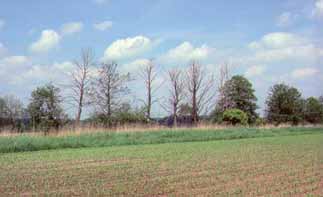PESTS AND DISEASES OF FORESTRY IN NEW ZEALAND
Facing the Phytophthora challenge
From Biosecurity, issue 99, August 2010.
Concerns are growing internationally as scientists learn more about the increasing number of serious plant and tree diseases found to be caused by Phytophthora species.
Phytophthora species have been known primarily as soil-inhabiting root-invaders that cause fatal root diseases. Infective spores have flagella (small tails) that enable the organisms to move freely in water and soil. One notable exception to this mode of action included P. infestans, the cause of potato blight. Spores of this species are aerially dispersed on moist air currents and infect the leaves and stalks of the potato plant.

However, within the past 15 years, new Phytophthora species have been described that have a lifecycle that is part or wholly above-ground, and our concept of the capabilities of Phytophthora species has changed. Part of this “new” understanding has been because of the development of molecular techniques for identifying and understanding relationships between species (Romberg, Biosecurity No 97, 2010), but a driving factor is the increasing number of serious plant and tree diseases found to be caused by Phytophthora species.
One of these new diseases is sudden oak death (SOD) caused by P. ramorum, a species of Phytophthora that was unknown 10 years ago. Phytophthora ramorum has killed millions of trees of many different species in the United States in the past decade and is also invading the United Kingdom and Eastern Europe.
Affected trees do not have root damage but trunk cankers, which may be high above the ground. Infective spores are not formed in the soil but on the foliage and shoots of understorey plants, usually of quite different plant species. These understorey plants often have only minor symptoms, or sometimes none at all.
An even more recent example is the emergence of the needle disease of Pinus radiata in Chile caused by P. pinifolia, discovered in 2004 and described in 2008. Both of these species of Phytophthora are considered to be invaders although their region of origin is not known.
While neither of these species is in New Zealand, MAF Biosecurity New Zealand (MAFBNZ) has specific measures in place to ensure that they do not get here.
Meanwhile, New Zealand kauri trees are under threat from a species of Phytophthora (known as “kauri dieback” – see www.arc.govt.nz/environment/biosecurity/kauri-dieback). Although this species has been in New Zealand for many years, it is still not known whether it is native or exotic.
Why are these new diseases emerging and where are these new species of Phytophthora coming from?
It is hypothesised that in the ecosystems in which these species evolved they cause little or no damage to the plant communities because of co-evolution with their hosts. They may colonise plant tissues without causing any symptoms of disease or they may live as propagules within the soil without causing root disease. When these species of Phytophthora are moved outside their native areas, they can come into contact with new hosts with no co-evolved defence response, therefore resulting in serious disease outbreaks.
In the northern hemisphere, the nursery trade has been implicated as the primary pathway for the spread of Phytophthora spp. across Europe and between continents. There are few restrictions on the movement of healthy plants and there has been little legislative recognition of the probability that such plant material is likely to carry unseen micro-organisms. The use of chemical control measures that can suppress disease symptoms may also facilitate the acceptance in trade of plant material bearing unseen plant pathogens.
Future risks

A further alarming prospect with the introduction of new species to a new environment is the potential for hybrid species of Phytophthora to form. Phytophthora alni and its varieties are thought to be the result of such an event. This hybrid species is killing millions of alders, which are a major component of riparian systems across Europe.
With expanding globalisation, there is an expectation that many more diseases caused by Phytophthora species will be discovered as new plant/microbe and microbe/microbe associations are facilitated by trade. Some experts predict that several hundred species of Phytophthora are yet to be described.
The protection of New Zealand’s biota from species of Phytophthora is a key part of MAFBNZ’s mandate, and import health standards consider the risks posed by Phytophthora spp.
The International Union of Forest Research Organisations (IUFRO) has a working party devoted to diseases of forests and natural ecosystems caused by species of Phytophthora.
This is an active working party that meets every second year, most recently hosted by Scion and Landcare Research in Rotorua in March.
The meeting was attended by more than 90 delegates from 14 countries, and topics ranged from Phytophthora biology to management and control. Sponsors of the conference included MAFBNZ, the Auckland Regional Council, Scion, Landcare Research and New Zealand Plant Protection Society. The next IUFRO meeting will be held in Eastern Europe in 2012.
Margaret Dick, Forest Science Group, Scion, margaret.dick@scionresearch.com

 Farm Forestry New Zealand
Farm Forestry New Zealand

